Thorpe Morieux is not really
on the way to anywhere, it is one of
those lost, remote Suffolk villages in
the hills between Stowmarket and
Hadleigh, a good five miles from the
nearest major road. It is not
particularly quaint, or picturesque. It's
a working village, surrounded by rolling
farmland. This is one of the last places
in Suffolk where you really cannot hear
the hum of distant traffic. For the
people who live here, Lavenham is the
local big town, which says it all really.
Morieux, pronounced M'-roo, was
the name of one of the parish manors.
This arrangement of the parish name is
far more common in Essex, but something
similar happened elsewhere in Suffolk at
Stonham Aspal. St Mary is a church that
you always see for the first time rising
over the fields. No matter from which way
you approach, there it is in the green
valley below. There is no village centre,
and the walk up to the church is between
cow fields.
You enter the churchyard from the west,
and the elegant tower thrusts up beyond
the lychgate. The church is hemmed in on
the south side by the tightness of the
churchyard which sprawls to the north and
west, but in any case it is the fields
around which provide the real setting. St
Mary is a a good example of that moment
where Dec is becoming Perp, everything in
the right place, an archetypal village
church. The wood and brick 15th Century
porch is simple and beautiful.
You step down rather suddenly into the
interior, and the nave falls away rapidly
towards the east. Two spectacular sights
await. The first is the grand
transitional font. This is one of the few
parts of Suffolk where Norman fonts are
commonly found, and you can see how
design had moved on in the century or so
since the Norman font at nearby Great
Bricett, for here we no longer have
elaborate reliefs, but the style is
increasingly elegant. In the decades to
come, fonts would lose their squareness
as well, but for now this one still
broods. Beyond the font is more elegance,
for the organ came from the Curzon chapel
in Mayfair, and brightens up what can be
a gloomy nave on a dull day. This is not
to disparage the glass, of course, which
is good of its kind, especially of the
20th and early 21st Centuries. Most
striking is Meg Lawrence's 2002 window
depicting St Peter and St Paul in her now
familiar style. 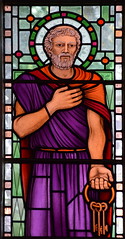 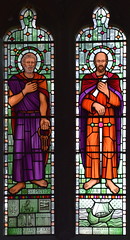 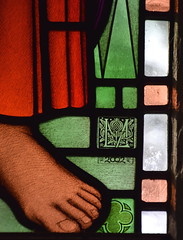 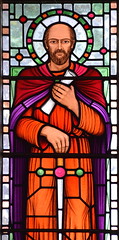
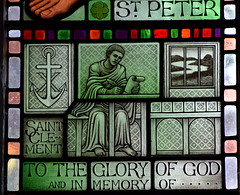 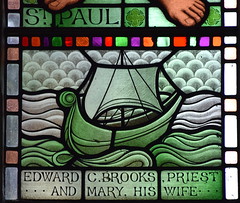
Nearby, the 1920s brought
Arthur Moore's overly sentimental St
George and St Francis, but note the small
child seated at the foot of St George,
appearing to play with the dragon as if
it were a favoured pet. I wondered if it
might be a portrait of the dedicatee, but
in fact this is a WWI memorial window to
two Temple brothers. Oddly, neither of
them is on the war memorial.
The east window of the previous century
features glass by the O'Connor brothers,
which has been partly reset in clear
glass. Some of the other glass may be by
Burlison & Grylls, and I thought I
detected the hand of William Wailes in
one of the other windows, although none
of these are signed. Most intriguing of
all is a window in memory of the nine
year old Louisa Temple, who died in 1877.
It shows her seated on the lap of Christ,
and may be an early work by Ward &
Hughes.
There is an unusual image bracket set in
the south wall, all vines and ivy.
Mortlock thinks it 15th Century, and not
in its original location. It seems to
have been found and moved at the time of
the 19th Century restoration, and later
made to form part of the war memorial.
Probably it was beside the altar to St
Nicholas, who Cautley says was the patron
of a guild here in the years before the
Reformation.
The chancel arch is flanked by two
hatchments. The one to the south of the
arch is interesting because it is the
latest in Suffolk, and one of the last in
England. It dates from 1934, and is for
one of the Warners of Thorpe Hall.
Stepping into the large chancel, there
are two fairly decent memorials to that
ubiquitous family in this part of the
world, the Fiskes. The better one, on the
north wall, dates from the late 18th
Century. The sill of the sanctuary south
window opposite drops to show that there
was a sedilia here once, but any remains
of it have been lost. The 13th Century
angled piscina beside it survives, with
an elegant column separating the two
parts.
Altogether then a handsome building, and
well worth a visit, with its setting in
the remote mid-Suffolk hills amid the now
quiet farmyards which bustled in an
earlier, busier age than today. Now,
nothing very much at all seems to happen
in Thorpe Morieux. Cycling onward up the
steep lonely road towards Hitcham, I
looked back into the valley, and saw the
impressive Thorpe Hall rise like a moon
behind St Mary.
|

